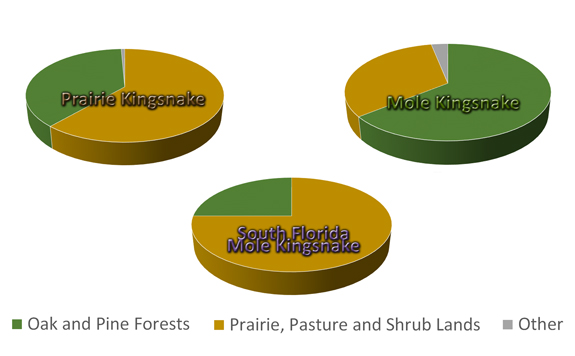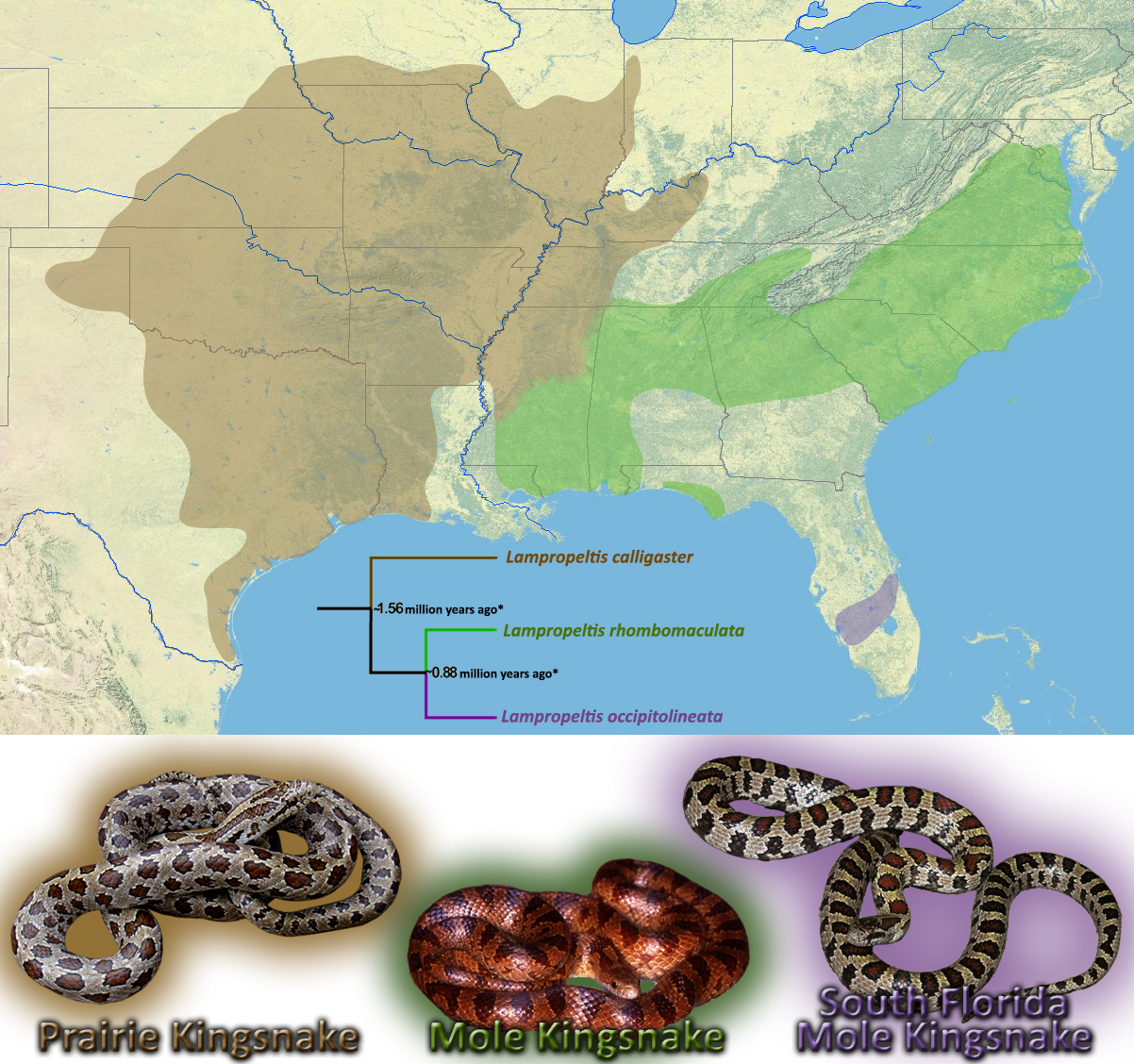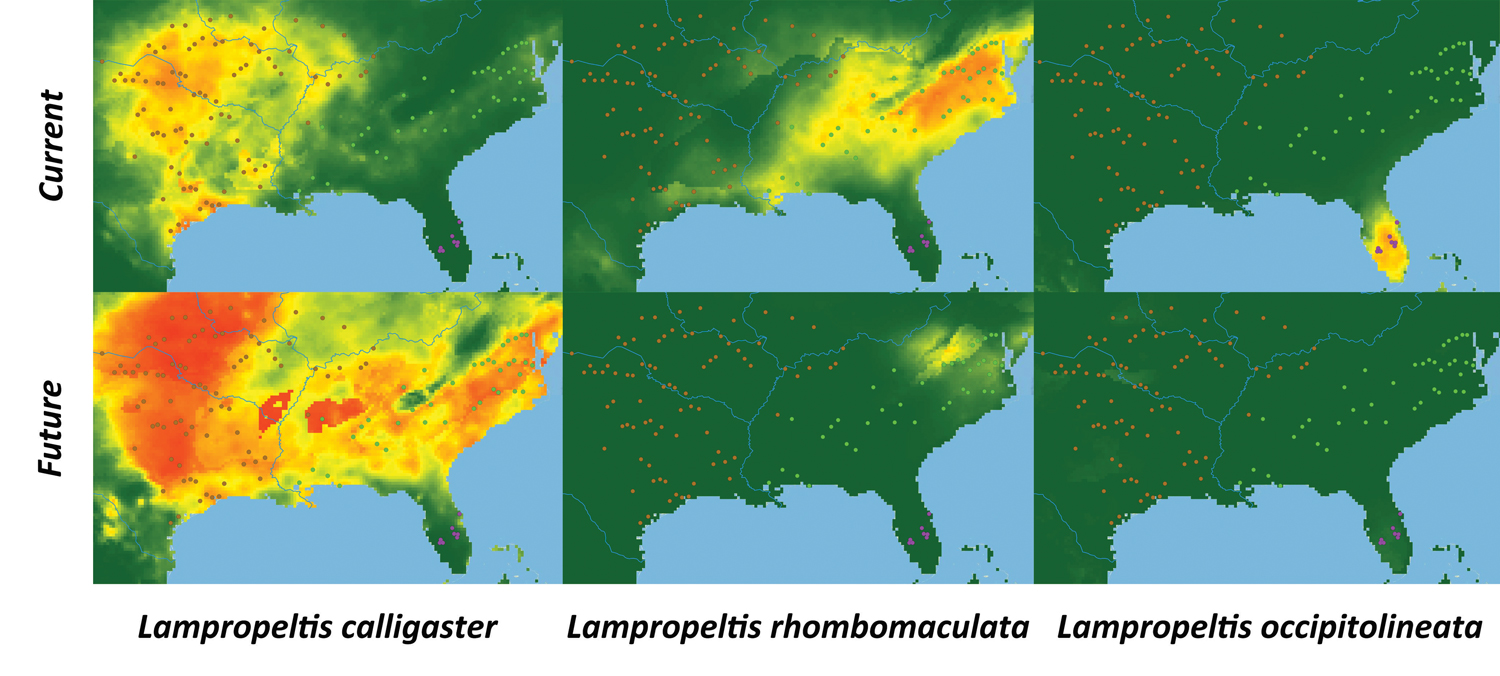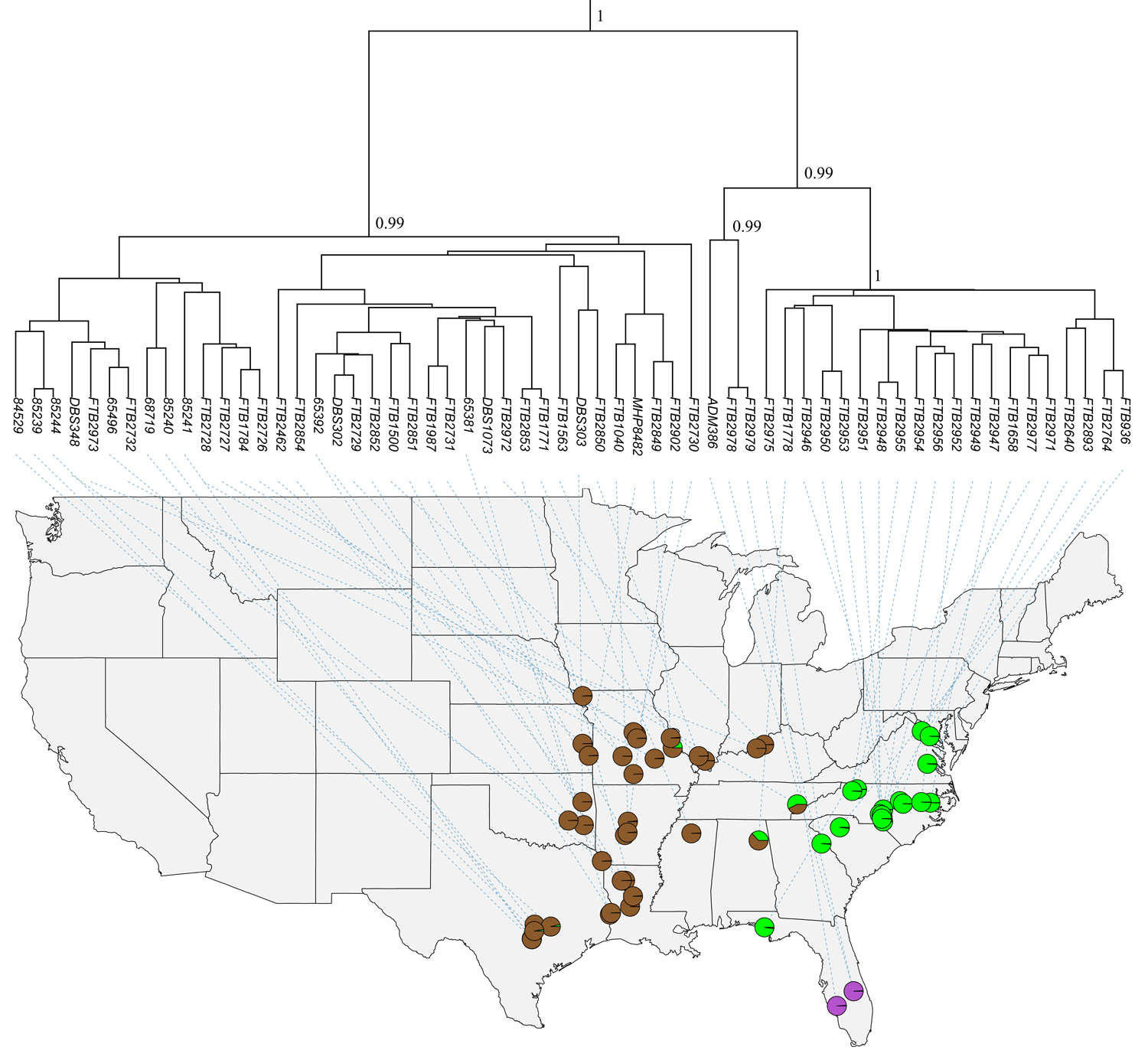Yellow-bellied Kingsnakes
Lampropeltis calligaster complex
The Yellow-bellied Kingsnake species complex of Eastern North America contains three species of similar-looking brownish, yellow bellied snakes with smooth scales. These secretive kingsnakes are variable in color and while rarely seen, are beautiful, enigmatic members of the community and have adapted across North America - each to its own habitat type. The map below shows the approximate extent of the range of the three currently recognized species. Click on each species to learn more about it, or scroll down to learn about the historical biogeography of this species complex, the storied history of of their taxonmy, how these species are affected by changing climate and what you can do to help understand and protect these species into the future.
Prairie Kingsnake Lampropeltis calligaster
- Brown in Map Above -
Mole Kingsnake Lampropeltis rhombomaculata
- Green in Map Above -
South Florida Mole Kingsnake Lampropeltis occipitolineata
- Purple in Map Above -
*date estimates (mya = millions of years ago) are statistical points in a range of values. In the case of the ~1.56 mya estimate of the divergence between Lampropeltis calligaster and the common ancestor of L. rhombomaculata and L. occipitolineata, the highest probability density (HPD) is calculated as centered around that 1.56 mya point, ranging from 0.64 to 2.92 million years ago.
The more recent divergence between L. rhombomaculata and L. occipitolineata occured ~0.88 million years ago (95% HPD = 0.003–1.72 mya).
Habitat Use in the Complex, by Species

Prairie Kingsnakes are found in the western prairies, Mole Kingsnakes in the eastern forests, and South Florida Mole Kingsnakes in South Florida wet prairies. Each species currently occupies a distinct ecological niche in Eastern North America. GAP land-cover data indicates that prairies and pastureland are preferred habitats for Prairie Kingsnakes in the west, and dry oak and pine forests are preferred for Mole Kingsnakes in the east. Signatures of migration suggest that speciation in these snakes was either accompanied by gene flow where niches overlap or has resumed in secondary contact. This separation in niche coupled with climatic shifts may have driven speciation.
In this species, genetic divergence is best described by environmental factors and only poorly by riverine vicariance of the Mississippi River. Interestingly, other species pairs reveal divergence near the Mississippi but diversification was likely driven by habitat changes; In Copperheads Agkistrodon controtrix, a transition in lineages found east of the Mississippi River roughly corresponds in location to these kingsnakes. Divergence times between copperhead lineages were reported overlapping those of the kingsnakes, at 0.96 MYA (0.46–1.56 MYA), indicating that both Yellow-bellied Kingsnakes and Copperhead lineages may have diverged at a similar time and area during the last ice age. It is possible, then, that the Mississippi River itself may not have been the driver of speciation, as indicated in other snake species, but rather the effect of ecological divergence into unique habitats found on each side of the river.
How will climate change impact these snakes?
Current and future range predictions based on year 2100 niche models species show an increase in potential niche range for Prairie Kingsnakes L. calligaster and decrease in range for Mole Kingsnakes L. rhombomaculata and South Florida Mole Kingnsnakes L. occipitolineata. In the figure below, warm colors indicate suitable areas for each species, while unsuitable areas are marked with cool colors. The dots on the maps are the localities of each species used in the original research for creating the environmental niche model.
Urbanization of the Florida landscape since 1960 has been faster than anywhere else in the US, with human population doubling every 20 years. Many species are threatened due to this, and coupling that with climate change imperils many additional species in Florida. While current and future niche projections of Prairie Kingsnakes indicate stable core habitat and increasing overall range, estimates of future climate reveal a troubling prediction for Mole and South Florida Mole Kingsnakes: areas once found suitable may change drastically over the next century. Assuming no adaptation, climate models indicate that there will be minimal preferred niche space remaining for these two species in 2100. Snakes such as South Florida Mole Kingnsnakes, locked in a rapidly developing peninsula, may not be able to migrate or adapt quickly enough to handle the effects of climate change and urbanization. Adaptive ecological affinity over time, or niche evolution, is likely far outpaced by climate change.
Uncovering the potential range shifts in these species highlights the downstream implications of species delimitation and the importance of phylogeography. Until recently, scientists thought this was a single species. We can't conseve what we don't know exists and stories like this are not rare in snakes.
Phylogeographic tree
The map above is an admixture map that shows phylogeographic relationships between species. Singly colored circles are "pure" animals whereas multicolored pies indicate mixed ancestry. The labels on the tips are collection names of individual specimens, tracable to public collections at universities and musuems.
Legacy species accounts and other common names:
Taxa names are hypotheses that are tested and revised. Species delimitation reveals that the Yellow-bellied Kingsnake complex is composed of three taxa that correspond with previously described subspecies. These three species occupy unique niches in North America and display quantifiable differences in morphology. For more see the original research link below.
All figures on this page adapted from work by:
McKelvy, A. D., & Burbrink, F. T. (2017). Ecological divergence in the yellow-bellied kingsnake (Lampropeltis calligaster) at two North American biodiversity hotspots. Molecular Phylogenetics and Evolution, 106, 61-72.
Link Below.
Links for Biologists and Educators:
Shapefiles for range and habitat [.asc xx mb]
Original Research on Yellow-bellied Kingsnake Phylogeography [Online PDF Full Text]
Slo












